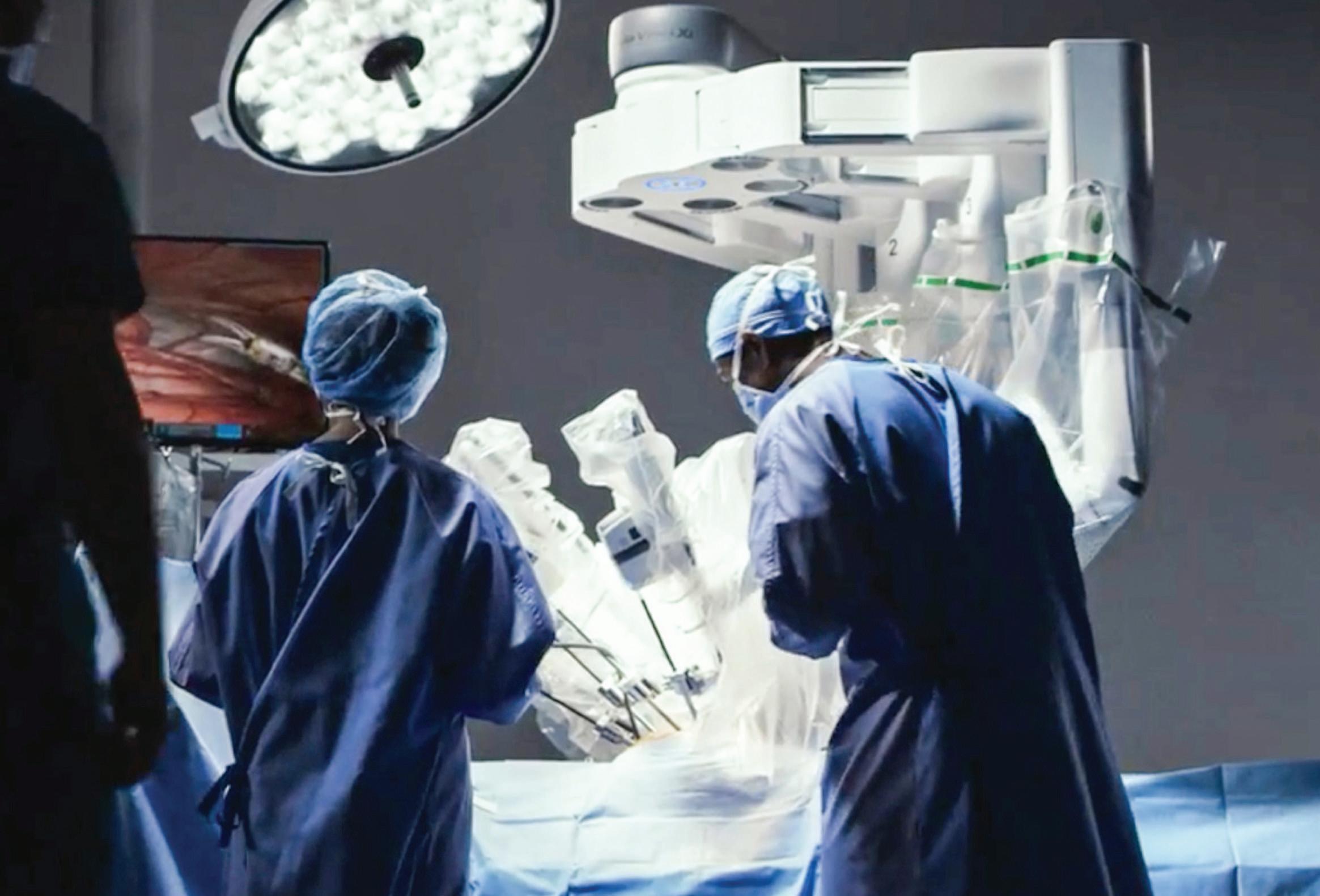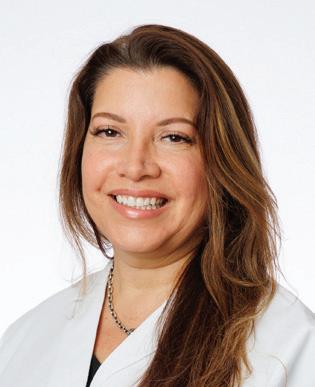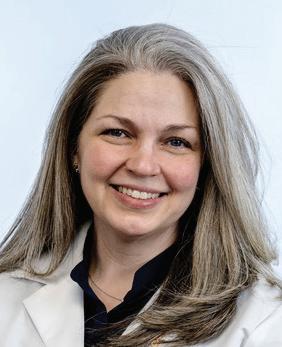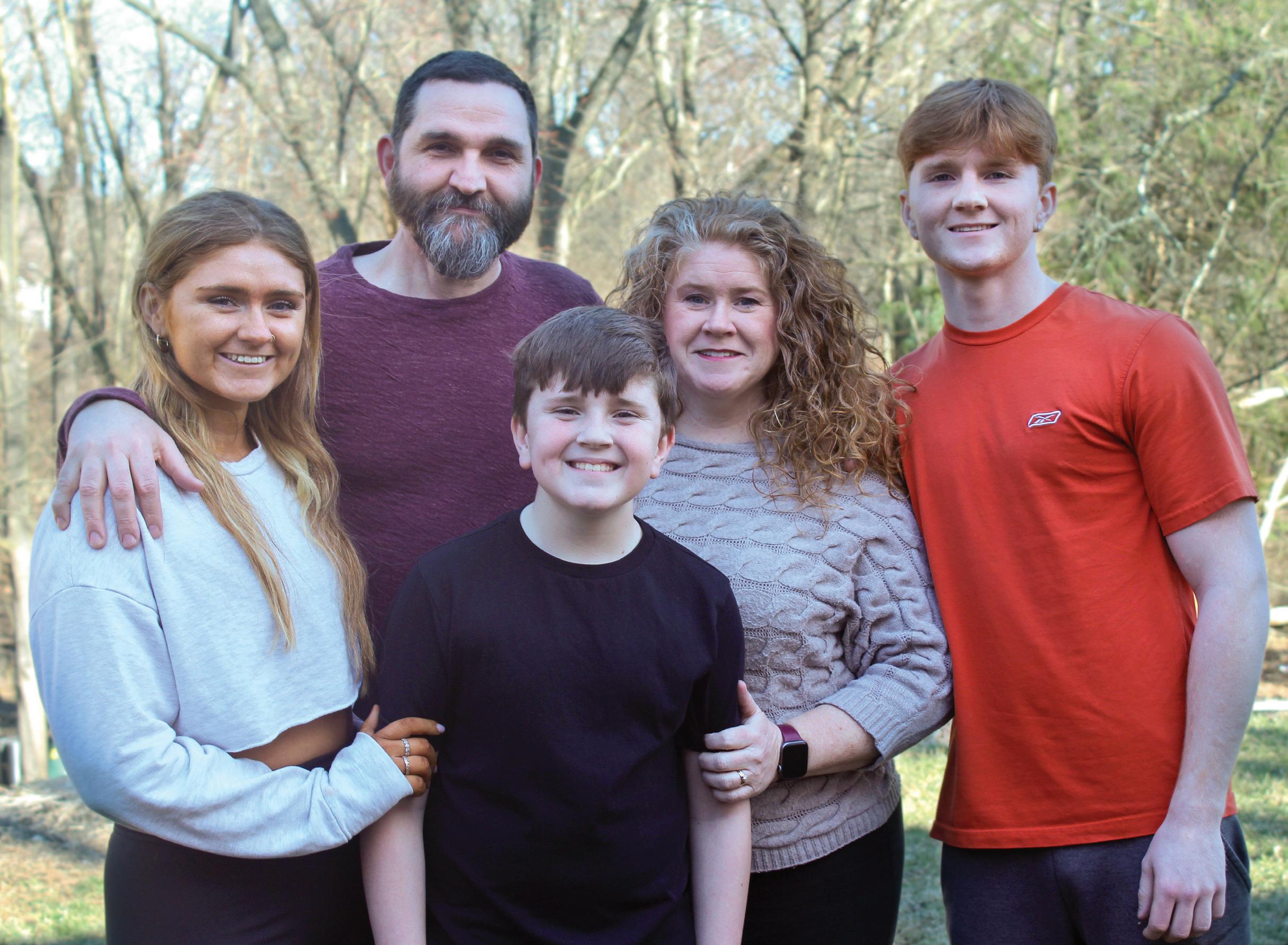HealthWorks
LESS INVASIVE HERNIA REPAIRS EASING SYMPTOMS OF MENOPAUSE

TO STOP A STROKE, BE FAST
5 EASY WAYS TO STRESS
LESS

LESS INVASIVE HERNIA REPAIRS EASING SYMPTOMS OF MENOPAUSE

TO STOP A STROKE, BE FAST
5 EASY WAYS TO STRESS
LESS
As the weather gets warmer, I encourage you to get outside and enjoy all that Rockland County and the Hudson Valley have to offer. Getting outdoors in the fresh air can do wonders for our physical and mental state. Increasing physical activity can make a huge difference in overall well-being and even improve our sense of community connection.
From 2013 to 2021, Rockland County was ranked among the top three New York State counties for overall health and was first four times! Currently, Rockland County ranks fourth according to this year’s County Health Rankings Report. When scoring a county’s overall health, two outcomes are considered: how long people live (length of life) and how healthy people feel while alive (quality of life). The Rankings Report also noted two areas for improvement in Rockland County: smoking cessation and obesity. They noted 14 percent of Rocklanders are smokers compared with a statewide average of 12 percent. Adult obesity in Rockland is 29 percent, with a 27 percent statewide average and an average of 32 percent nationally. You can read the full report at www.countyhealthrankings.org.
If age-related wear and tear, an old sports injury or an acute injury is preventing you from enjoying a more active lifestyle, Montefiore Nyack Hospital now offers robotic surgery performed by our experts of Montefiore Einstein Orthopedic Surgery. Roboticassisted surgery is a true game changer, leading to superior surgical outcomes including faster recovery and fewer complications. Montefiore Nyack Hospital is one of the few in the region offering a choice of either the MAKO or ROSA orthopedic robots. We are also excited to announce that in January 2024 we will begin treating our first patients at our new, state-of-the-art Montefiore Einstein Orthopedic Center of Excellence in West Nyack. This Center of Excellence is a collaboration between Montefiore Einstein, Montefiore Nyack and Burke Rehabilitation Hospital, and promises to transform the delivery of orthopedic medicine. It will include physician offices; an ambulatory surgery center; high field strength open orthopedic MRI; and physical therapy services.
In an effort to raise Rockland County’s overall health in next year’s County Health Rankings, please view Montefiore Nyack Hospital and its affiliated physicians as a valuable community resource for health education, treatment and prevention. Visit our newly updated website to stay apprised of topical health news and our ever-expanding specialties and services. Feel free to join our Community Health and Wellness Department’s live webinars on Thursdays at noon or download them on YouTube at Montefiore Nyack Community Chats.
Best wishes for a happy and healthy summer,
The Jacobs Family Pride Wellness Center of Montefiore Nyack Hospital is the first medical health center of its kind to bring services to LGBTQ+ (lesbian, gay, bisexual, transgender and queer plus) residents of Rockland, Orange and Bergen counties and the Lower Hudson Valley. The Center is located in a private, off-campus site in Nyack.
In partnership with the Oval Center at Montefiore, the AIDS Center at Montefiore Medical Center and the Phyllis B. Frank Pride Center of Rockland County, The Jacobs Family Pride Wellness Center provides affirming and confidential medical care that focuses on the needs of the LGBTQ+ community ages 16 and up. Referrals are available for individuals younger than 16, including care for transgender, nonbinary and gender-expansive young people.
Montefiore Nyack Hospital participates in the Healthcare Equality Index (HEI), a national benchmarking tool for LGBTQ+ healthcare administered by the Human Rights Campaign. The program evaluates healthcare facilities’ policies and practices related to the equity and inclusion of their LGBTQ+ patients, visitors and employees. We’re proud to be rated a Top Performer.
 Mark Geller, MD President and Chief Executive Officer
Mark Geller, MD President and Chief Executive Officer

facebook.com/MontefioreNyack

@MontefioreNyack
@MontefioreNyack
@Montefiore_Nyack
To unsubscribe, please email us at publicrelations@montefiorenyack.org.
linkedin.com/MontefioreNyackHospital
For a list of services provided, visit www.montefiorenyack.org/pride-wellnesscenter/for-patients
Lauren Malone, Assoc. VP, PR and Marketing
Rose Croke, Marketing Manager/Photographer
Briana Tolve, Marketing Manager
Jasmine Gonzalez, Marketing Coordinator
Celia Vimont, Writer
4 ROBOTIC REPAIRS THAT HEAL HERNIAS
Minimally invasive procedures using advanced technology can speed recovery.
6
FINDING HELP FOR ALCOHOL USE DISORDER

How to know if you have a drinking problem—and what to do about it.
8 A VISION FOR VOLUNTEERING
Directing hospital volunteers is a highlight of a hospital administrator’s four-decade career.
10
MANAGE STRESS TO IMPROVE YOUR HEALTH
Learn to tame tension through deep breathing, regular meditation, healthy eating and more.

Montefiore Nyack Hospital has earned The Joint Commission’s Gold Seal of Approval® and the American Stroke Association’s Heart-Check mark for certification as a Primary Stroke Center.
In earning The Joint Commission’s designation, Montefiore Nyack Hospital underwent a rigorous, unannounced on-site review of our Stroke Program. A team of Joint Commission surveyors conducted observations and interviews for compliance with related certification standards that included program management, supporting self-management, and delivering and facilitating clinical care.
12
MENOPAUSE: HOW TO REDUCE SYMPTOMS

Steps that include lifestyle changes and medical treatments can ease a natural transition.

14
STOPPING A STROKE IN ITS TRACKS
Knowing the symptoms of stroke helped a man get lifesaving treatment in time.
This certification reflects our commitment to providing the highest quality of care for stroke patients by reducing variation in our clinical processes and strengthening our program structure and management framework for stroke patients. To learn more, visit www.JointCommission.org.

An estimated 27 percent of men and 3 percent of women develop a common type of hernia called an inguinal hernia at some point in their lives. Hernias tend to grow larger and cause symptoms over time, and most need to be surgically repaired. Many hernia patients can now be treated with robotically assisted laparoscopic surgery, according to Lee Fleischer, MD, FACS, Director of Surgery at Montefiore Nyack Hospital and a surgeon with Highland Medical.

“Robotically assisted surgery has a number of advantages over other types of hernia surgery, including a shorter recovery, less or no opioid medication and a quicker return to normal activities,” Dr. Fleischer says.

A hernia is a tear or defect in the abdominal wall that allows an internal organ such as the intestines to bulge out. An inguinal hernia occurs in the groin. You may be able to see the bulge of a hernia, depending on its location and size.
A hernia may cause aching pain in the area, a feeling of pressure or pain that worsens with activities such as heavy lifting,
pushing and straining. Sometimes the hernia bulge is unable to be placed back in the abdomen, meaning it’s incarcerated, necessitating emergency surgical repair.
A doctor will usually diagnose a hernia by taking a medical history and performing a physical exam. If necessary, the doctor may use imaging tests such as CT (computed tomography), MRI (magnetic resonance imaging) or ultrasound to help with the diagnosis.
If a hernia is not causing symptoms, the doctor may recommend waiting to treat it. But when troubling symptoms start, the next step is to decide what type of
LEE FLEISCHER, MD, FACSsurgery is best, depending on factors such as a patient’s age and overall health.
There are two types of hernia surgery: open surgery and minimally invasive (laparoscopic) surgery. Open surgery requires a larger cut to make the repair and has a longer recovery time.
Laparoscopic surgery is less invasive, and surgeons at Montefiore Nyack Hospital treat many patients with robotically assisted laparoscopic procedures using the da Vinci Surgical System.
The da Vinci system has four robotic arms instead of a surgeon’s two arms. In contrast to regular laparoscopic instruments that are long, thin, straight and unbendable, the da Vinci robotic surgery system features instruments with multiple joints. “It can maneuver better than a human arm or hand can,” Dr. Fleischer says. “The system allows the surgeon to produce finer movements with more accuracy. Because of this, surgery is even less invasive than regular laparoscopic surgery, which means less pain for the patient and a shorter time for recovery.”
With minimally invasive surgery using the da Vinci system, the surgeon makes small cuts through which robotic surgical instruments and a laparoscope (a thin tube with a light and a camera lens) are inserted. Sitting at a console, the surgeon uses controls to perform the surgery.
Patients go home on the same day as the surgery. Those with desk jobs can go back to work within a week. People with physically taxing jobs can usually go back in two weeks. Patients can drive a few days after surgery.
“If you develop a hernia, there’s no reason to worry,” Dr. Fleischer says. “It’s easy to fix, and you’ll get back to your normal activities quickly.”
Highland Surgical Associates, located at 1 Crosfield Avenue, Suite 105, in West Nyack, offers patients a range of surgical treatments from minimally invasive laparoscopic and robotically assisted procedures to complex surgical care. To schedule a consultation, call 845-535-3362.
An inguinal hernia occurs when intestines or other abdominal tissues bulge through the abdominal wall into the inguinal, or groin, area. Related factors include:
Pain when coughing, exercising or bending over
Burning sensations Sharp pain Heavy or full sensation in the groin
In men, swelling or pain around the testicles
Any activity or medical problem that puts or allows pressure on abdominal wall tissue and muscles may lead to or worsen a hernia:
activity or lifting
Pregnancy Cystic fibrosis Enlarged prostate (straining to urinate)
Use proper lifting techniques.
Lose weight if overweight.
constipation (straining to have bowel movements)
Undescended testicles
Extra body weight
Relieve/avoid constipation. Consume plenty of fiber and fluids; use the bathroom as soon as you have the urge; exercise regularly.
Men: See your healthcare provider if you strain to urinate, a sign of prostate enlargement.
Seek immediate medical care if a hernia is associated with fever; nausea or vomiting; sudden, intensifying pain; a dark, red or purple bulge; or an inability to move bowels or pass gas.
The line between regular drinking and problem drinking can be difficult to recognize. Often people with an alcohol problem will convince themselves they aren’t drinking too much.
“If you do have an alcohol problem, it’s likely you won’t be able to stick to just one drink a day for more than a couple of days—the craving will be too much,” says Kristine Medora, a chemical dependency counselor at The Recovery Center at Montefiore Nyack Hospital.
Alcohol use disorder (AUD), or problematic drinking, is a chronic disease of uncontrolled drinking and preoccupation with alcohol. It can vary from mild to severe. “We saw a big increase in drinking problems due to the pandemic,” Medora says. “People were more isolated and anxious.”
There are many types of help for people with a drinking problem, no matter how severe. These include behavioral therapies, medications and mutual support groups such as
The first step of recovery for a person with AUD is to recognize that an issue exists. “Generally, if your alcohol use is interfering with major life obligations, it’s likely you are a problem drinker,” Medora says.
If you are thinking about treatment, start by talking with your primary care doctor. Your doctor can evaluate your drinking pattern and refer you for further

treatment. A doctor diagnoses AUD by asking a series of questions about alcohol use, including:
In the past year, have you:
• Had times when you ended up drinking more or longer than you intended?
• More than once wanted to cut down or stop drinking, or tried to but couldn’t?
You can find help and information about alcohol problems at:
• The Recovery Center at Montefiore Nyack Hospital www.montefiorenyack.org/addiction-recovery 845-348-2075
• Rockland Council on Alcohol and Other Drug Dependencies www.rcadd.org
• Alcoholics Anonymous www.aa.org/find-aa
• Spent a lot of time drinking, being sick from drinking or getting over other aftereffects?
• Wanted a drink so badly you couldn’t think of anything else?
• Found that drinking—or being sick from drinking—often interfered with taking care of your home or family, or caused job or school problems?
• Continued to drink even though it was creating trouble with your family or friends?
• Given up or cut back on activities that were important, interesting or pleasurable to you in order to drink?
If you are trying to help a loved one with a drinking problem, it’s important to keep the lines of communication open, Medora says. “Try to leave judgment out of it,” she advises. “There’s so much stigma surrounding any kind of substance use, including alcohol use.” Try to be patient with your loved one, and when you see that they are making an effort, give them encouragement.
Treatment often involves behavioral therapy or counseling. This treatment can include developing skills needed to stop or reduce drinking; helping to build
a strong social support system; working to set reachable goals; and coping with or avoiding triggers that may cause relapse.
At The Recovery Center at Montefiore Nyack Hospital, patients are given an in-depth assessment. Depending on their situation, they will be engaged in both group and individual counseling one or more times a week. “It’s very client-centered,” Medora says. “When a person comes in, we assess them based on their drinking and what supports they have. Are they working? Whom do they have at home?”
Patients may be prescribed medication for dependence on alcohol and/or other substances. There are currently three medications approved by the U.S. Food and Drug Administration for treating alcohol dependence.
Patients with a co-occurring disorder such as depression or anxiety meet with a psychiatrist. The Center runs family group sessions once a week. “Research has shown that family involvement increases a patient’s chance of success,” Medora says.
She encourages patients to participate in mutual support groups such as AA. For those who prefer other group settings, she recommends a religious institution, gym or even an art class. “The more connections you make, the better your chances of staying sober,” she says.
For general questions about outpatient services at The Recovery Center at Montefiore Nyack Hospital, call 845-348-2075 or visit www.montefiorenyack.org/addiction-recovery.


In 1980, the world was introduced to CNN, Pac-Man and Post-it Notes. Locally, Montefiore Nyack Hospital had the great fortune of hiring Helen Hayes-Perkins, who at that time was just starting her long and dedicated career serving patients and visitors, helping fellow employees and encouraging change throughout the hospital.
Hayes-Perkins has held many positions at Montefiore Nyack Hospital in the past 43 years, but says her current role as Director of Volunteer Services has been one of the most fulfilling. “This is a fantastic, rewarding job,” she says. “The volunteers are amazing people with so much life experience. Some have been here for more than 30 years. We have a warm, caring and talented group of adults and students who make a difference in the lives of our patients, their families and our staff.”
Hayes-Perkins first came to Montefiore Nyack Hospital as a college intern studying to be a diet technician. Her many jobs have included Director of Food Services, Administrator of Support Services and Administrator of Patient Satisfaction. She received a degree in healthcare administration from Long Island University and has run the Volunteer Services Department for the past 12 years.
Hayes-Perkins interviews, trains and manages all volunteers, who come from many different backgrounds, including healthcare professionals, stay-at-home parents and retired adults. They range in age from 15 to mid-90s.
“Volunteers are here for a variety of reasons—to see if the healthcare
field is right for them, building skills, meeting new people or giving back to the community,” Hayes-Perkins says. “We have volunteers who lost a loved one and want to give back, and we have husband-and-wife volunteers.”
Hayes-Perkins and her office team work to find every volunteer a position they will enjoy. Some assignments may involve working directly with patients, while others focus on more clerical program support and many ancillary departments.
“There’s something for everybody here,” Hayes-Perkins says. “Some volunteers love volunteering in the ER because there’s always something going on and they want to stay busy. Other people enjoy interacting with patients or doing office work.”
Adult volunteer positions at Montefiore Nyack Hospital include:
• Helping with pet therapy
• Working as a certified therapeutic musician
• Assembling patient comfort kits
• Assisting with the baby cuddler program (holding babies in the Intensive Care Nursery with the permission of parents who aren’t able to be at the hospital)
• Delivering snacks to patients
• Visiting patients (comfort care)
• Joining creative hearts (volunteers who work from home making baby hats and comfort blankets)
• Staffing the gift shop
• Helping with the Ambassador Program (patient navigation)
To become a part of the volunteer team, fill out an application online at www.montefiorenyack.org/about-us/volunteering. To learn more, email volunteer@montefiorenyack.org.
There are also a variety of volunteer opportunities for teens and college students. These include the VolunTEEN program, which gives teens a firsthand look at what a career in healthcare is all about. The NASH (Nyack Academy Students in Health) program allows senior high school students to rotate through different hospital departments.
College and premed programs give students a chance to experience working in the medical field and enhance their medical school application. Summer and school-year volunteer programs are available.
Perks for volunteers include a jacket for adults and shirts for students, a complimentary meal and free parking. Volunteers are asked to commit to at least 150 hours of service over a six-month period (for students, at least 62 hours during the summer). All volunteers are carefully screened and thoroughly trained.
Volunteers provide help to the hospital staff and brighten patients’ experiences. “Their presence as caring, compassionate volunteers adds a personal touch to what might be a stressful time for patients and families,” Hayes-Perkins says.
When she is not working, HayesPerkins manages to find time in her busy schedule to volunteer herself. For the past eight years, she has served her local community as an auxiliary police officer in Rockland County. She is also the proud smallbusiness owner of Perkins Preserves, a Valley Cottage-based store that offers a wide selection of delicious jams, preserves and mouthwatering baked goods.
DIRECTING HOSPITAL VOLUNTEERS IS A CAREER HIGHLIGHT FOR AN ADMINISTRATOR WHO HAS SPENT MORE THAN FOUR DECADES MAKING A DIFFERENCE.
YOU CAN TAME TENSION WITH TECHNIQUES SUCH AS DEEP BREATHING, MEDITATION AND MAINTAINING HEALTHY HABITS.

Stress can compromise our health and well-being—physically, mentally and spiritually. When patients come to Lorraine Olivero, DNP, FNP-BC, with health issues related to stress, she explains how they can use a variety of lifestyle tools to navigate stressful situations.

“From deep breathing and meditation to adopting healthier eating and sleeping habits, people can learn to lower their stress level and improve their health and vitality,” says Olivero, a board-certified family nurse practitioner at Highland Medical, Palisades Primary Care and Pulmonary Medicine, in West Nyack.
There are two types of stress: acute (short-term) and chronic (long-term). Acute stress elicits our fight-or-flight
response to deter a dangerous situation. Your blood pressure, heart rate, breathing rate and levels of muscle tension may skyrocket for a short time.
Chronic stress occurs over time and can lead to a variety of consequences, including insomnia, anxiety, depression, panic attacks, weight gain, memory problems and headaches. Long-term stress can increase inflammation in the body, leading to a number of chronic health conditions including metabolic disease, fatigue, brain fog and cardiovascular disease. Stress also can compromise the immune system, which may lead to increased vulnerability to infections such as the flu or the common cold.
Whether your stress is acute or ongoing, deep breathing exercises can help you relax. Olivero teaches her patients a technique called box breathing. “It helps to reset the nervous system when you’re feeling overwhelmed,” she says.
To practice box breathing, sit with your spine straight. Then, while breathing through your nose:

• Inhale for four counts.
• Hold your breath in for four counts.
• Exhale for four counts.
• Hold your breath out for four counts.
Other ways to reduce stress include:
Eating healthfully.
“We truly are what we eat,” Olivero says. “I advise patients to avoid sugar or refined carbohydrates, which can be inflammatory. Also avoid processed foods, fried foods and artificial ingredients. Instead, focus on eating fresh foods such as organic vegetables,
fruits, herbs and healthy proteins such as wild-caught fish or grass/ pasture-fed meat and poultry.”
Connecting with nature. “As you face the sun, place your feet on the earth and just breathe,” she says.
Getting enough sleep.
“Optimizing sleep is important because the body rejuvenates itself while asleep or at rest,” Olivero says. Electronics often interfere with a good night’s sleep. “Many people are using their phone or watching TV before bed,” she notes. “The blue light that’s emitted from electronics interferes with brain chemicals that tell our body it’s time to go to sleep.” She recommends avoiding artificial light and food within two to three hours of bedtime and sleeping in a dark, cool room.
Try sitting upright in a chair with your hands on your thighs. Repeat “I am” silently in your head for 20 minutes. If your mind wanders, let thoughts move along—don’t engage with them. After 20 minutes, sit still for another three minutes with no thoughts. “If you can do this twice a day—when you wake up and again in the afternoon, perhaps during your lunch break—it helps to create a state of balance,” Olivero says. “Patients tell me that when they meditate, it makes them more efficient and they can handle stressors more easily.”
To find a primary care provider in your area, visit www.highlandmedicalpc.com/specialties/primary-care.
Whether your stress is acute or ongoing, deep breathing exercises can help you RELAX.

Menopause brings with it many changes. While some are positive, others can be challenging—but women can take a number of steps to ease their transition, says Maria Emerson, MD, FACOG, Director
cold during the night, leading to trouble sleeping. Vaginal dryness often results from the body’s drop in estrogen.
help maintain heart health, which is important because heart disease risk increases after menopause.
of OBS-GYNat Montefiore Nyack Hospital and Highland Medical OBS-GYN of Rockland.
Menopause is marked by the absence of menstrual periods for an entire year. The ovaries stop working and estrogen decreases. Many menopause symptoms are associated with the decline in estrogen.
Before menopause begins, women enter a phase called perimenopause, or the menopause transition, which can last for several years. Women may start experiencing changes to their menstrual cycle such as spotting before or after their period, or shorter or longer times between periods. They may also start to have other symptoms several years or more before they enter menopause.
Hot flushes, also known as hot flashes, are one of the most common menopause symptoms. “This is heat that rises in the upper body,” Dr. Emerson says. “Everybody else around you is comfortable, but you feel like you’re on fire.” Another common symptom is night sweats: You may feel hot and
Women going through menopause may gain weight. “Women say, ‘I haven’t changed my diet or exercise routine, so why do I suddenly have a spare tire around my waist?’” Dr. Emerson says. Mood swings are also common. “You may feel more frustrated or quicker to jump at things,” she says. Decreased sex drive and headaches are other symptoms.
“It’s important to remember that menopause does have advantages such as no longer having a period, cramps, headaches and breast tenderness every month,” Dr. Emerson says.
In the past, estrogen replacement therapy was a popular treatment for menopausal symptoms such as hot flushes. Dr. Emerson says she does not generally prescribe estrogen replacement therapy for patients because of concerns that it might increase the risk of certain cancers, including breast.

• Exercise to help with hot flushes and mood swings. Weight-bearing exercise also helps prevent osteoporosis, which becomes more common after menopause. Cardio exercises
• Antidepressants. “A small dose of antidepressant medication is approved by the U.S. Food and Drug Administration for treating hot flashes,” Dr. Emerson says.
• Vaginal creams, suppositories or rings to treat vaginal dryness. “With menopause comes the loss of elasticity of the vagina, which can make sex painful,” Dr. Emerson says. Helpful vaginal creams aren’t absorbed well in the body, so they don’t increase the risk of breast cancer.
• Foods with natural estrogens. Try adding items such as yams, lentils and soy products to your diet on days you’re feeling really uncomfortable.
Other tips to deal with hot flushes include layering clothing so you can take off layers when the heat hits, always having a cool drink nearby and lowering the temperature in your home.
Some women find acupuncture beneficial for hot flushes, while others say the herb black cohosh or the Chinese herb dong quai can help. Dr. Emerson cautions that these supplements are not FDA-approved and it’s difficult to know how much you’re getting.
“If you’re having trouble with symptoms that interfere with your daily life, talk with your doctor about steps you can take,” Dr. Emerson advises.
If you would like to discuss any menopausal symptoms with a gynecologist, visit www.highlandmedicalpc.com/specialties/obs-gyn-of-rockland.
GARY HALEY RECEIVED LIFESAVING TREATMENT IN TIME THANKS TO HIS KNOWLEDGE OF STROKE SYMPTOMS.

On December 4, 2022, Gary Haley was home after a physically demanding workday at Cushman & Wakefield/UBS, where he is an engineer. He was about to start decorating the house for Christmas when he realized something was wrong.
“Suddenly I had problems walking on my right side,” says Gary, age 49. “I had no control of my arm or hand.” Gary then noticed that his right leg was dragging, and he knew he had to get to the hospital immediately. He quickly went to Montefiore Nyack Hospital, which was a key factor in Gary’s successful treatment, according to Inna Bulaevsky, DO, the attending physician who treated him in the hospital’s Emergency Department (ED).
“Getting to the hospital as soon as a person realizes they may be having a stroke is critical,” Dr. Bulaevsky says. “If you feel a sudden weakness or loss of sensation in your face, arm or leg, or have sudden difficulty with speech, balance or coordination, you need to call 911. These are possible signs of a stroke, and you need to be evaluated in the ED right away.”
A person who comes to the ED with a possible stroke is immediately taken for a CT (computed tomography) scan to check for bleeding in the brain. “There are two types of stroke,” Dr. Bulaevsky says. “The most common type involves a clot that impedes blood flow to the brain, known as an ischemic stroke. The other type is a hemorrhagic stroke, which involves bleeding in the brain. We need to know which type it is in order to know
how to treat it.”
Gary’s CT showed that he had an ischemic stroke, and he was started on a medication called tenecteplase (TNK) to dissolve the clot and allow blood flow to return to the brain. In most cases, stroke patients should receive TNK or another common treatment known as tissue plasminogen activator (tPA) within three hours of the start of the stroke in order for the medications to be effective, Dr. Bulaevsky says.
“The longer an area of the brain goes without blood, the greater the chances that the area will be damaged—and that the damage could be permanent,” says Andrew Erian, MD, a neurologist at Highland Medical, Rockland Neurological Associates, in West Nyack, and co-director of the Stroke Committee at Montefiore Nyack Hospital.

Within 45 minutes to an hour of receiving treatment, Gary started to feel better. He was transferred to the intensive care unit to be monitored and stayed for three nights. He has been receiving physical therapy and is back at work.
“Recovery from a stroke depends on its severity and the type of symptoms a person has,” Dr. Erian says. “Most people can expect to do intensive rehabilitation for several months, which can include physical therapy, occupational therapy and speech therapy, to get the brain to re-form the connections that were damaged by the stroke.”
A person recovering from a stroke also needs what Dr. Erian calls a “tune-up process”—taking measures such as getting their blood pressure, cholesterol and diabetes under control, quitting smoking and being examined by other specialists. “These are all steps that decrease the risk
B.E. F.A.S.T.The faster you get to the Emergency Department during or after a stroke, the better your chances for successful treatment. An easy way to identify key signs of a stroke is to remember the acronym B.E. F.A.S.T.:
B
BALANCE: Sudden trouble with balance or coordination
E
F
EYES: Change in vision
FACE: Drooping or numbness
A ARM: No control; weakness or numbness
S SPEECH: Change in speech or ability to talk clearly
TIME: Is brain, meaning fast action reduces risks. Call 911.
T
of a person having another stroke and increase the chances of a good recovery,” he says.
Dr. Bulaevsky says Gary’s instinct to get to the hospital as soon as he recognized his symptoms very well could have saved his life: “We were able to help Mr. Haley preserve his ability to work and take care of his family because he came in as soon as possible.”
To make an appointment with a board-certified neurologist at Highland Medical, P.C., call 866-550-HMPC (4672).
ANDREW ERIAN, MDJoin us for the 37th Annual Northeastern Anesthesia & Montefiore Nyack Hospital Medical Staff Golf Classic on Monday, July 17, 2023, at Rockland Country Club in Sparkill, NY. A full day of activities has been planned, including:

• Brunch
• Barbecue Lunch
• Cocktail Reception
• Dinner
• Awards Ceremony
• Raffles
TO REGISTER
LEARN MORE AT: montefiorenyackfoundation.org foundation@montefiorenyack.org
845-348-2770
